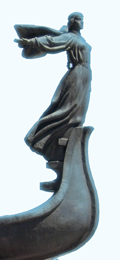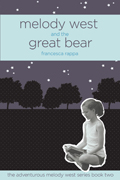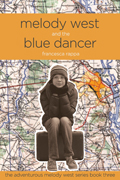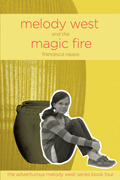Comments are closed.
Blue Dancer
 I just returned home from my fabuloso trip to Kyiv with my all-girl chorus, where we performed the Negro spiritual “Swing Low, Sweet Chariot” and the traditional Ukrainian folk song “Carol of the Bells.” We performed at St. Nicholas’ Cathedral in front of girls from all around the world, and it was an awesome experience! I had to sing a solo part, which made me nervous, but I mustered up the courage and sang with all my heart. Where is Kyiv? Kyiv is the capital city in Ukraine, and Ukraine is a country in central Europe. Before I tell you what I learned on my trip, I should tell you about my recent visit to Maplewood’s art museum, because what I saw at the art museum is key to the mystery I would later try to solve in Kyiv.
I just returned home from my fabuloso trip to Kyiv with my all-girl chorus, where we performed the Negro spiritual “Swing Low, Sweet Chariot” and the traditional Ukrainian folk song “Carol of the Bells.” We performed at St. Nicholas’ Cathedral in front of girls from all around the world, and it was an awesome experience! I had to sing a solo part, which made me nervous, but I mustered up the courage and sang with all my heart. Where is Kyiv? Kyiv is the capital city in Ukraine, and Ukraine is a country in central Europe. Before I tell you what I learned on my trip, I should tell you about my recent visit to Maplewood’s art museum, because what I saw at the art museum is key to the mystery I would later try to solve in Kyiv.
Deirdre Maples is a docent and she agreed to give Annie and James and me a private tour of the art museum. I remember I almost gasped when we drove through the museum’s entryway. The museum shimmered in the sunlight and the rooftop was wavy like a flying carpet! First Deirdre showed us a piece of sculpture called Large Spindle Piece by the British artist Henry Moore. The sculpture was made out of a shiny, yellowish-brown metal, and it reflected the sun and sky. James thought it looked like some kind of mysterious machine, but Annie thought it looked more like a cloud in the sky. Annie and James are both right. Each person draws on his own experience when looking at art. As Deirdre says, we give art meaning through our own experience and knowledge and emotions.
We entered the museum and right away we noticed three huge figures that were made out of some type of molded plastic. These figures were sitting flush against the wall and were high up. They were lit from inside and glowed. Deirdre told us they were called Doors of Jerusalem and were made by the Spanish artist Jaume Plensa. Deirdre said the figures were guardians of the museum who would help guide us. Annie and James and I stood underneath one of the figures for a few moments, and then Deirdre quickly led us to the Classical Gallery. The marble statue of Venus was amazing! Ancient Greek and Roman artists had made these statues thousands of years ago. James said the Ancient Greeks created the first democracy where every male citizen over the age of eighteen could participate in government. I remembered what I had learned in school about the American Revolutionary War and how the American patriots fought against the King of England to create a democracy here in the United States. During my trip to Kyiv, I would learn that the struggle to create new forms of government is not a thing of the past, and that several countries including Ukraine had recently chosen to become democracies.
Next we saw a dark metal sculpture of three tall male figures called The Three Shades made by the French artist Auguste Rodin. James told us the Shades are mythological spirits of the underworld. I have to admit that as I looked at the Shades floating on top of a pond in the courtyard garden outside, I was a bit frightened. Then Annie said something interesting. She said she could almost see the artist’s fingerprints in the metal. Deirdre agreed and said Rodin liked to show rough and detailed surfaces and emotions in his sculpture. I was starting to realize artists have very different styles and approaches to art.
Finally we saw the piece I liked the most. We saw the Blue Dancer made by Ukrainian artist Alexander Archipenko. The statue was made out of metal and was covered in a blue-colored patina, which is a film on the surface of the metal. In the ceiling above the dancer’s head, several round skylights softly directed the sunlight onto the surface of her smooth, blue body. James said, “She sure is blue!” We circled around and tried to stand on our toes while lifting one of our legs in the air like the Blue Dancer. It was clear Deirdre loved the Blue Dancer, and I understood why. In the soft light that filtered down from above, the dancer’s body appeared to flash and sway and rotate. The Blue Dancer seemed to have something important to say. I tried to figure out her secret message but she danced on, unwilling to make her secret known. Would I discover her secret in Kyiv?
When our plane landed in Kyiv early in the morning, I was a little unsteady on my feet and my hair was a bit ruffled. I was nervous because everything was foreign to me. I couldn’t even read the  signs! But then I met Katya, the president of our sister chorus in Kyiv, and I was happy to learn that Katya spoke perfect English. I would be staying with Katya and her family for the next few days while touring the city. Katya was preparing to celebrate her name-day party with her relatives and friends. A name-day party in Ukraine is like a birthday party here in the United States. During the party I learned all about Ukraine’s history and culture. What did I learn? First I learned that the fertile, black soil of Ukraine’s defenseless and open steppe attracted warriors of other nations, and these nations ended up ruling Ukraine for many many years. Today, for the first time since the Vikings first established a nation here with the native people one thousand years ago, Ukraine is united as a strong, independent nation.
signs! But then I met Katya, the president of our sister chorus in Kyiv, and I was happy to learn that Katya spoke perfect English. I would be staying with Katya and her family for the next few days while touring the city. Katya was preparing to celebrate her name-day party with her relatives and friends. A name-day party in Ukraine is like a birthday party here in the United States. During the party I learned all about Ukraine’s history and culture. What did I learn? First I learned that the fertile, black soil of Ukraine’s defenseless and open steppe attracted warriors of other nations, and these nations ended up ruling Ukraine for many many years. Today, for the first time since the Vikings first established a nation here with the native people one thousand years ago, Ukraine is united as a strong, independent nation.
Right before the party I met Katya’s older sister, Olena. Olena was wearing traditional Ukrainian clothing woven with colorful threads into patterns called embroidery. On top of her head she wore a headdress of woven flowers and ribbons. Soon all the guests arrived and everyone sat down for dinner. We were served cold appetizers, dumplings made from soft dough and filled with cheese, and cabbage roles stuffed with ground meat and rice and stewed in tomatoes. Everything was delicious! After dinner Olena played the bandura, and two boys who were also dressed in traditional clothing danced the hopak. What is a bandura? The bandura is Ukraine’s national instrument. You pluck the bandura’s strings like a harp’s stings. Long ago only blind men played the bandura. As the blind men played, they recited poems about how the Ukrainian people struggled against invaders. What is the hopak? The hopak is a Ukrainian folk dance where the dancer squats down low, kicks out his feet, and then jumps into the air. The Kozaks performed its many years ago. The Kozaks were like our American cowboys. They rode horses across the Ukrainian steppe and lived adventurously in frontier settlements.
In addition to learning all about Ukraine and her people, I learned something more about the Blue Dancer at the name-day party. I met a young artist named Andrivy, and Andrivy told me he had seen Archipenko’s Blue Dancer. Andrivy insisted the Blue Dancer was magical and filled with mystery. He said the dancer was like the ancient stone figures that were set up across the Ukrainian steppe by the ancient people long ago as guards against invading warriors. According to Andrivy, the Blue Dancer had the power to inspire and bring back a person’s will to create. It had happened to Andrivy, and I wanted it to happen to me. I wanted to find out the dancer’s secret and become inspired. I wanted to give a performance in St. Nicholas’ Cathedral with my chorus that I would remember for the rest of my life!
I returned home to Maplewood with many wonderful memories and many beautiful gifts. My favorite gift was the two pysanky I received from my new friend, Katya’s great grandmother Ana. Ana was a famous ballerina in Russia and Ukraine. Pysanky are decorated eggs and are traditionally given to others as a token of friendship and good fortune in the spring. My favorite pysanky is the one with the white background that indicates my future is a blank page that has yet to be written. Ana told me what it was like to be a dancer and how there are many different styles of dance. I remember everything Ana told me. She said that when times are difficult and people are uncertain about the future, there is an even greater need for art. “Art can lift a people’s spirit and work miracles,” she said. Ana found her inspiration as a dancer and teacher. She told Katya and me to find out what we love to do most in the world and then put our hearts into it. If we did so, our futures would be full of promise and magic for sure!
famous ballerina in Russia and Ukraine. Pysanky are decorated eggs and are traditionally given to others as a token of friendship and good fortune in the spring. My favorite pysanky is the one with the white background that indicates my future is a blank page that has yet to be written. Ana told me what it was like to be a dancer and how there are many different styles of dance. I remember everything Ana told me. She said that when times are difficult and people are uncertain about the future, there is an even greater need for art. “Art can lift a people’s spirit and work miracles,” she said. Ana found her inspiration as a dancer and teacher. She told Katya and me to find out what we love to do most in the world and then put our hearts into it. If we did so, our futures would be full of promise and magic for sure!
Did I discover the secret of the Blue Dancer? Perhaps. I’ll simply leave you with the Blue Dancer’s image in your minds in the hope that art will lift your spirits and inspire you to create something beautiful too!
~mTw~
Filed under | Comments Off on Blue Dancer



